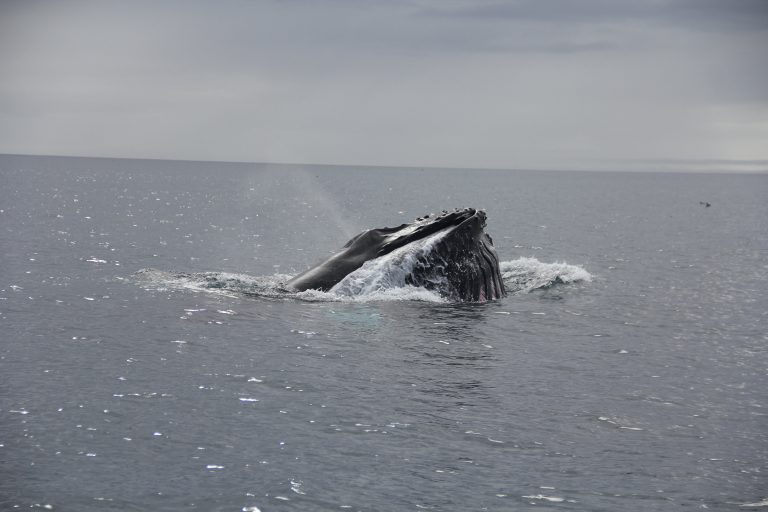What and how do whales eat? Considering the fact that we have to distinguish between two bigger suborders of whales – the baleen whales (Mysticetes) and the toothed whales (Odontocetes), both food sources and preying techniques are highly varying between these two groups. Let’s have a closer look:
We gonna start with the toothed whales, including all species of dolphins and porpoises, but also sperm whales and beaked whales for example. As the name already indicates, species belonging into this group have teeth. However, latter will only be used to catch and tear their prey apart, never to chew it as we humans are used to do. As these animals are actively hunting within the water column, they can feed on fish, squid, several crustacean species or even other marine mammals. Here in the southwest of Iceland we have two species of toothed whales, which can be seen regularly on our whale watching trips.
To be more precise, these are the white-beaked dolphins and harbour porpoises. Both are feeding on smaller fish and squid species including herring, capelin, and any kind of cephalopods, respectively. Due to an oceanographic process known as up-welling, massive amounts of nutrients getting vertically transported, supporting the growth of algae of all kinds at the water surface. Hence, huge fish swarms are occurring in Icelandic coastal and offshore waters in late spring, early summer, for their feeding season. Taking now a closer look into the trophic levels of the marine food-web, we will see, that all whales and dolphins are highly dependent on these processes, in order to find themselves enough food out of lower trophic levels.

Examining the second order, the baleen whales, organisms show a completely different strategy of feeding. They don’t have any kind of teeth, but so-called ‘baleen plates’. Baleen plates are made out of keratin, the same material our human hair and fingernails are existent of. Given, that every whale possesses a couple hundreds of theses plates, the functionality is comparable to a sieve. Hence, a common way to obtain food for these whales is filter feeding. Hereby, representative species are skimming through the water column or even right below the surface, having their mouth widely opened up. This process is also known as ‘gulping’. Since the baleen bristles are tightly packed in the whale’s upper jaw, the gulped in water can be drained easily, whilst the filtered food can’t get out anymore. Applying this method, mainly consumed organisms are any kind of plankton or some smaller fish species defined as sand eel.

(Humpback whale gulping some smaller fish on the water surface)
Another feeding technique that can be observed, is known as ‘bubble-feeding’. This process is described by whales swimming in circles around and also underneath their prey, creating a net of bubbles, which will confuse the prey and herd it together. This technique is mainly applied to fish swarms. As soon as the net of bubbles keeps the fish contained, the whale can easily swim into the herded fish and loads its mouth with food. You can observe this feeding behaviour regularly applied by humpback whales (Megaptera novaeangliae) in Icelandic waters around spring season.
Since hunting and feeding procedures vary between species and most times also between the areas assessed, having such a richness of both toothed and baleen whales entering and feeding in Iceland’s marine environments is a delight for everyone on our Whale watching tours.

Blog by:
Annika Heimrich (Guide)
Special Tours Wildlife Adventures









